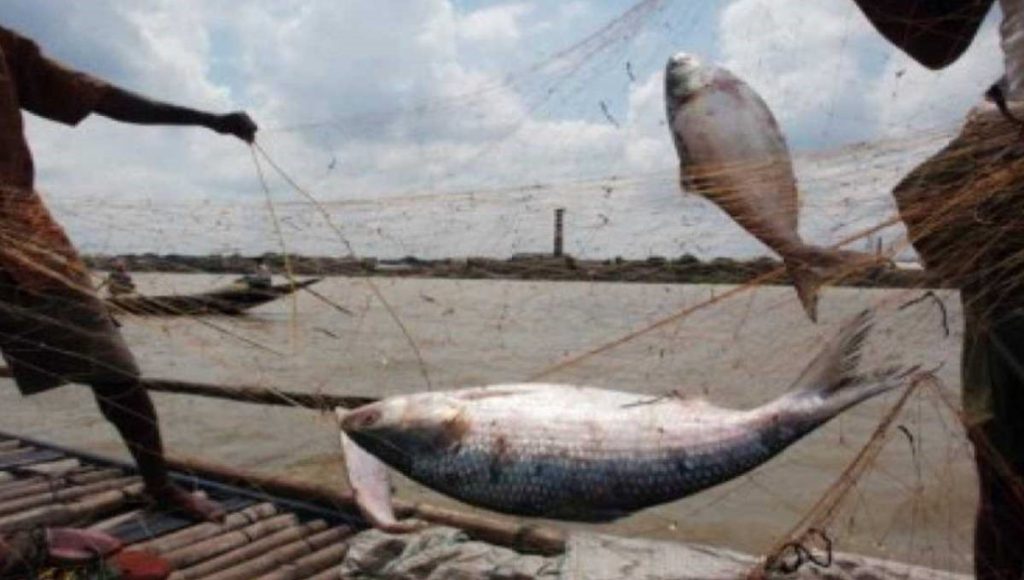Khulna, Jul 31 – Bangladesh’s fishermen are overjoyed as they have returned to the Bay of Bengal after a 65-day ban to find an abundance of hilsa, their prized catch.

A number of trawlers with hilsa have been anchoring on the Daratana River in front of the KB Bazar in Bagerhat daily since the ban was lifted on July 24. Witnesses said fishermen, traders and warehouse owners were seen passing a busy time there.
One was seen fetching buckets, the other was busy packaging while another was sending them to different parts of the country.
The coveted ‘Maach er Raja’ (The King of Fish), with its silver sheen, has flooded the local markets of the coastal areas of the country including Satkhira, Khulna and Bagerhat, said locals.
Its price also went down as there is enough supply in the market. Hilsa weighing 450 gm to 500 gm is available at Tk 500-550, one weighing 600 gm to 700 gm would cost Tk 650 -700, while 800 gm to 900 gm is available within Tk 1,000.
Owners of the fish warehouses said the price was nearly double only a week back but since the ban ended it has come down to a rational level.
Fish sellers said the price of hilsa was high coinciding with the ban from May 20 to July 23.
Sales of hilsa has been on the rise in Khulna City Corporation wholesale fish market, Khulna’s largest wholesale market, as well as by street hawkers who sell fish on the city roads and door to door at reasonable prices.
Hilsa weighing a full kilogram is being sold at Tk 1,200, again half the price from just a week back. Comfort and peace returned to the minds of buyers and sellers for its price reduction and availability. Thousands of buyers were seen hovering around the fish markets where most of them were buying their favorite fish, hilsa.
Abu Musa, owner of Madina Fish warehouse, confirmed that a huge number of hilsa has been netted in the week since the ban was lifted. He is selling a 400 gm/500 gm/ 600 gm hilsa at Tk 500 while those weighing a kilogram were available at Tk 800.
Liton, who is working at Bengal Fisheries, said hilsa from the sea is more expensive than hilsa from rivers. Before July 23, five tonnes of hilsa reached the local market everyday but last Friday, July 25, a whopping 60-70 tonnes of hilsa hit the market.
President of Fish Warehouse Association ASM Abed Ali said during the 65-day ban fishermen and their families had to live in inhuman conditions, but now they are happy with lots of hilsa and higher rate of sale.
He also expressed satisfaction over the sizes of the individual hilsa that they’ve caught, adding that if the rain continues they will be able to net even larger hilsa.
Bagerhat District Fisheries Officer Md Khaled Kanak said the fishermen have started to enjoy the positive outcomes of the hilsa ban.
More hilsa will be available in the district next year, he predicted.
As part of its policy to boost fish stocks, particularly to conserve and protect hilsa, the government had imposed a 65-day ban on saltwater fishing.
Last year, the Food and Agriculture Organisation (FAO) ranked Bangladesh as the fifth biggest aquaculture producer in the world. Aquaculture or aqua farming is defined by FAO as the production of fish, crustaceans, mollusks, and marine plants.
Meanwhile, hilsa production has jumped from 298,000 metric tonnes in the 2008-09 fiscal, to almost 500,000 metric tonnes in 2017-18, according to the Ministry of Fisheries and Livestock. – UNB




